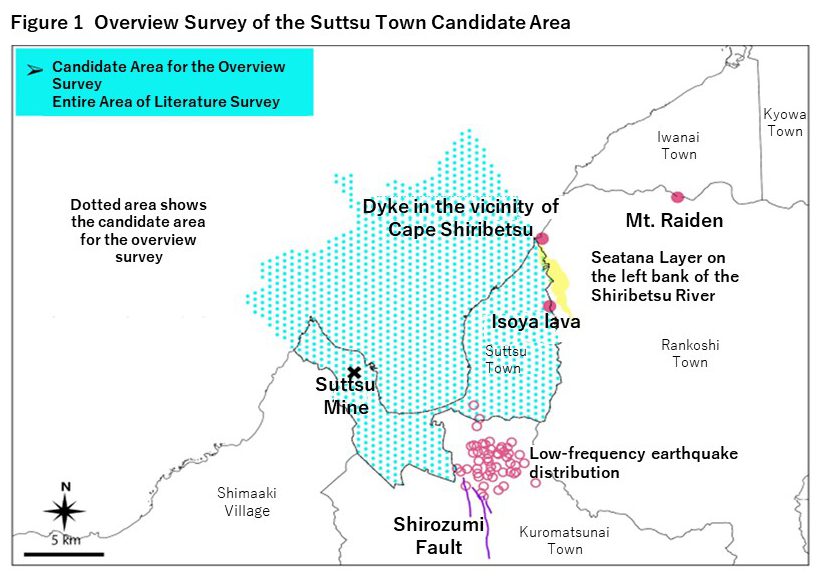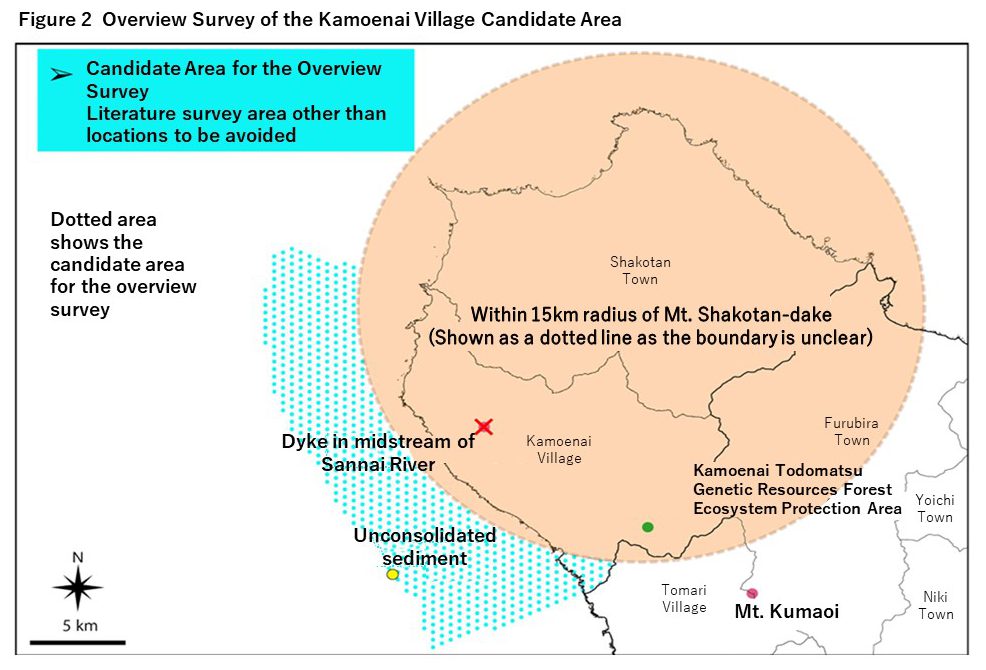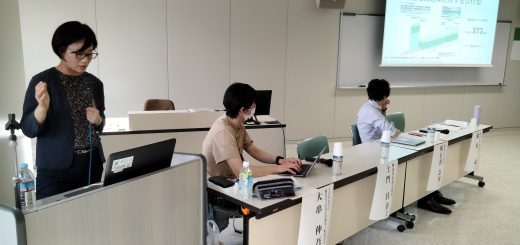NUMO’s Problem-loaded Literature Survey Reports
By Takano Satoshi
・NUMO submitted its literature survey reports on November 22. Public inspection and hearings were held until February 19.
・Doubts about completion of the report while ignoring the results of the dating of Isoya lava in the eastern part of Suttsu Town
・Suttsu Town thrown into a state of confusion for four years by a literature survey of doubtful value
On November 22, the Nuclear Waste Management Organization of Japan (NUMO) submitted the reports of the literature survey to Mayor Kataoka Haruo of Suttsu Town, Mayor Takahashi Masayuki of Kamoenai Village, both in Hokkaido, and Hokkaido Governor Suzuki Naomichi. The literature survey, the first phase of a survey for the construction of a final disposal site for high-level radioactive nuclear waste, is one in which literature related to the safety of geological disposal, such as data on volcanoes, active faults, erosion and uplift, and mineral resources are collected and evaluated. The reports have finally been published, four years after the survey began in November 2020. We examine here the contents of the problem-loaded reports.
Background to the completion of the reports
The method of evaluation and examination of the amassed literature was discussed when the literature surveys in Suttsu Town and Kamoenai Village were almost completed. The discussions were held in the Specified Radioactive Waste Subcommittee (the Subcommittee) 1) and the Geological Disposal Technical Working Group (Technical WG) 2), two councils of the Ministry of Economy, Trade and Industry (METI). In particular, specialist discussions were held in the Technical WG, the members of which are scholars recommended by academia related to geological disposal.
Reflecting the discussions in the Technical WG, the “Assessment Approach for the Literature Survey Phase” was formulated in November 2023. Problems were already apparent at this point. For a site to be selected for the overview survey, the next stage after the literature survey, the Act on the Final Disposal of Specified Radioactive Waste (Final Disposal Act), which governs surveys for the selection of disposal sites, requires that “there is no record of significant changes in geological formations due to natural phenomena such as earthquakes” and that “it is expected that there will be little risk of significant changes in geological formations caused by natural phenomena such as earthquakes in the future.” However, as it was difficult to confirm that “there are no records” or “there is little risk” using this assessment approach, the standard was altered to identify sites where it was clear that “there are records” or “there is a strong risk.” The grounds for stating what was “clear” or “strong” were themselves not clarified, and thus the standard was essentially relaxed.
In accordance with this assessment approach, NUMO published the “Draft Literature Survey Reports” in February 2024, following which the Technical WG discussed whether the draft reports were prepared in accordance with the approach, and all deliberations, including those in the subcommittee, were completed in August. On November 22, NUMO completed and released the literature survey reports.3), 4)
Content of the questionable report
As shown in Figures 1 and 2, according to the completed reports, the entire area of Suttsu Town and the area of Kamoenai Village, excluding the area within 15 km of Mt. Shakotan-dake, were selected as areas for the overview survey. This is almost the same as the map of “Scientific Features” formulated by the government in 2017, which shows areas relatively suitable for geological disposal. In Suttsu Town, the Shirozumi Fault, considered unsuitable due to concerns about possible impacts from the active fault, was included in the overview survey candidate area. This is because it is said that while the distribution of active faults may extend underground in the southern part of Suttsu Town the detailed distribution is unknown.
 Safety concerns other than the assessment of the Shirozumi Fault were mentioned in the process of the discussions in the Technical WG. One was the fact that low-frequency earthquakes, small tremors with a lower frequency than normal seismic waves, occur frequently in the southern part of Suttsu Town. Another was the fact that the Nuclear Regulation Authority (NRA) has pointed out that the Shakotan Peninsula western fault, off the coast of Kamoenai Village, is a possible active fault. It has also been pointed out that the hyaloclastite rock (water-cooled fractured rock) material that exists over a wide area in Suttsu Town and Kamoenai Village was formed by the eruption of submarine volcanoes, and as the magma was rapidly cooled by seawater, some parts of the rock are heterogeneous and extremely fragile. Although all of these were indicated as “points of concern,” safety concerns that could fall under the criteria for avoiding geological disposal, it was decided to reconfirm these points in the overview surveys.
Safety concerns other than the assessment of the Shirozumi Fault were mentioned in the process of the discussions in the Technical WG. One was the fact that low-frequency earthquakes, small tremors with a lower frequency than normal seismic waves, occur frequently in the southern part of Suttsu Town. Another was the fact that the Nuclear Regulation Authority (NRA) has pointed out that the Shakotan Peninsula western fault, off the coast of Kamoenai Village, is a possible active fault. It has also been pointed out that the hyaloclastite rock (water-cooled fractured rock) material that exists over a wide area in Suttsu Town and Kamoenai Village was formed by the eruption of submarine volcanoes, and as the magma was rapidly cooled by seawater, some parts of the rock are heterogeneous and extremely fragile. Although all of these were indicated as “points of concern,” safety concerns that could fall under the criteria for avoiding geological disposal, it was decided to reconfirm these points in the overview surveys.
The following are carried out in the overview survey: physical exploration to understand the situation underground using physical phenomena such as elastic waves and electric currents; surface exploration to investigate geological phenomena that can be confirmed on the surface of the ground; and boring surveys to examine geological conditions by drilling holes and collecting samples of bedrock. The reports did not specify what kind of research would be carried out in which area.
Results of the dating of the Isoya lava in eastern Suttsu Town ignored
An event symbolic of NUMO’s attitude toward proceeding to the overview survey without fully discussing safety concerns also occurred. This was the dating of the Isoya lava in eastern Suttsu Town. On October 16, about a month before the report was completed, Professor emeritus Okamura Satoshi of Hokkaido University of Education presented the results of a dating survey of the Isoya lava in eastern Suttsu Town at the Volcanological Society of Japan.
According to the survey, the Isoya lava was active from about 2.1 million to 3.3 million years ago, and thus can be regarded as a Quaternary volcano that was active after about 2.58 million years ago. In the assessment approach of the literature survey stage, the area within 15 km from the activity center of a Quaternary volcano should be considered as a criterion for avoiding construction of a disposal site. Therefore, if the Isoya lava is a Quaternary volcano, since almost all of Suttsu Town falls within that zone, the impact would be enormous. Prof. Geshi Nobuo, vice president of the Volcanological Society of Japan and a member of the Technical WG, stated his opinion in a newspaper report, saying, “It should have been treated as a Quaternary volcano… If the findings had been obtained before the conclusion of the deliberations on the report, the Isoya lava area would have been excluded.”
NUMO, on the other hand, stated that Prof. Okamura had given an oral presentation, and that it would confirm the contents of the presentation when it becomes “documents and data that are of high quality and generally available,” such as academic papers. NUMO’s attitude, which appeared to ignore Prof. Okamura’s new findings and to rush to complete the report as soon as possible, led to a series of protests in which civil society pointed out the deterioration of credibility of the research process. 5)
The meaning of reversibility under scrutiny
The stance that even if new findings raising concerns about safety appear they should be reconfirmed at the next stage of the survey is contrary to government policy thus far. In June 2024, the Technical WG compiled a Deliberation Report on Technical and Expert Perspectives Based on the Statement on Geological Disposal. The report indicated the policy that “It is important that the national government and NUMO share with the public the recognition that information should be repeatedly checked and discussed, including stopping and retracing steps in some cases, in the step-by-step survey process for selecting a disposal site.”
Going back further, the WG Interim Report on Radioactive Waste, prepared in May 2014, also states that “It is essential to ensure reversibility and recoverability, and to establish a mechanism that enables people, including future generations, to review decision-making on final disposal.” Reversibility is defined as “Reversing or reconsidering decisions made during the realization of the disposal system.” In other words, the government itself has expressed the importance of having the flexibility to reconsider decisions made in geological disposal projects.
Doubts remain on whether NUMO’s decision to complete the report without reflecting Prof. Okamura’s new findings was appropriate from the viewpoint of reversibility. The policy of emphasizing reversibility is correct, but the fact that the very first literature survey has resulted in such confusion indicates that there are problems in its practical implementation. In the near future, METI needs to convene the Subcommittee and Technical WG to discuss specific rules for reversibility.
Four years of confusion in Suttsu Town due to the literature survey
The core of the literature survey reports, which took four years to complete, seems to have been for the purpose of creating an alibi for the government and NUMO to say that what they could find out from the literature survey was extremely limited, and that they would therefore have to proceed with the overview survey. In fact, the reports state the policy that “the effects of wide-area phenomena such as the impacts of active faults and volcanoes are basically grasped at the overview survey stage and are excluded from the scope of the following detailed survey.” It is difficult to see the significance of conducting a literature survey if it is not possible to assess cases such as faults and volcanoes that have an extremely serious impact on the safety of geological disposal.
Looking back, the residents of Suttsu Town were not notified of the application for the literature survey until the last minute. As Mayor Kataoka ignored the need to build a consensus among the local community in submitting the application unilaterally, the result was that divisions appeared within the community. Conversations among residents were reduced because they wanted to avoid topics related to the literature survey. When people became aware of who approved or disapproved of the survey, they would even avoid going to shops owned by people with differing views. Why did the people of Suttsu Town have to be thrown into confusion and have the bonds of their community damaged for four years by a meaningless literature survey? METI and NUMO must be held accountable for this.
Future of the Literature Survey
According to the enforcement regulations of the Final Disposal Act, public inspection of the literature survey reports and holding of hearings on the reports are required for at least one month from the date of public notice. In Hokkaido, hearings will be held mainly in 14 administrative districts until February 19. During this time, hearings will also be held in the four cities of Tokyo, Osaka, Nagoya, and Hiroshima. During the two weeks from February 19 until March 5, when public inspection of the reports ends, citizens will be able to submit comments on the reports by mail or online. After expressing their views on the opinions received, NUMO will apply to METI with an implementation plan for an overview survey. The Minister for the Economy, Trade and Industry will take the views of the governor of Hokkaido and the mayors of Suttsu Town and Kamoenai Village into account before deciding whether or not to approve the reports and will not proceed against their wishes.
Even after the reports were submitted, Governor Suzuki of Hokkaido expressed his opposition to the reports, saying, “There is currently no change in my intention to express a contrary opinion.” It is necessary for us citizens to participate in the hearings, point out technical problems in the reports, and hold NUMO accountable for the divisions that have occurred in Suttsu Town. In addition, we would like to create an environment where it is easy for Governor Suzuki to express his opposition by submitting a large number of objections to moving forward with the overview survey.
1) At the time, this was called the Radioactive Waste Working Group under the Nuclear Power Subcommittee. In July 2023, the organization was reorganized into a subcommittee independent of the Nuclear Subcommittee, and the name was changed to the current name.
2) At the time, it was a working group under the Nuclear Power Subcommittee. In a reorganization in July 2023, it became a working group under the Specified Radioactive Waste Subcommittee.
3) Suttsu Town Literature Survey Report (Japanese) www.numo.or.jp/chisoushobun/survey_status/suttu/pdf/01_suttu_honbun.pdf
4) Kamoenai Village Literature Survey Report (Japanese) www.numo.or.jp/chisoushobun/survey_status/kamoenai/pdf/01_kamoenai_honbun.pdf
5) Reference: CNIC Statement: NUMO Should Resubmit its Report on the Literature Survey (English) cnic.jp/english/?p=7930
Statement of the Association Working on the National Statement of the Issue of Geological Disposal of Nuclear Waste (Japanese) cnic.jp/52281

